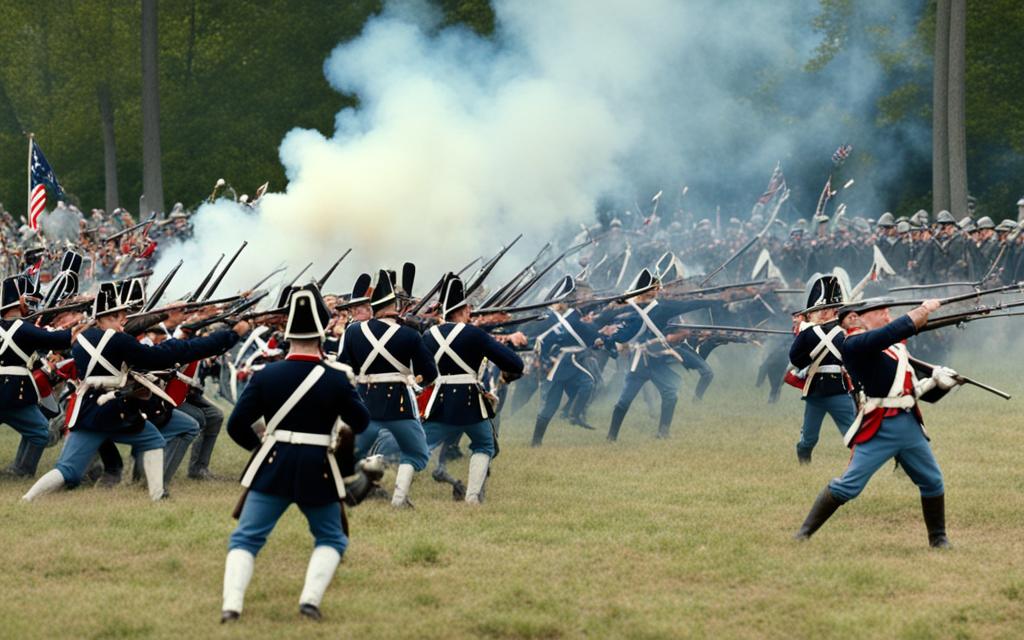The Battle of Camden was a pivotal moment in the American Revolutionary War, taking place on August 16, 1780 in South Carolina. It pitted the British forces under Lieutenant General Charles Cornwallis against the American Continental Army led by Major General Horatio Gates. The battle proved to be a decisive victory for the British, significantly shaping the course of the Southern campaign of the war. This article will delve into the historical context, key figures and strategies, consequences, and lasting significance of the Battle of Camden.
Historical Context of the Battle of Camden
The Battle of Camden took place amidst the backdrop of the American Revolutionary War, which had been raging since 1775. By 1780, the historical context of the battle of camden had shifted to the Southern colonies, with the British seeking to regain control of the region. After the American defeat at the Battle of Charleston in May 1780, the British Commander-in-Chief in North America, Sir Henry Clinton, left Lieutenant General Charles Cornwallis in command of British forces in the southern campaign. Cornwallis’ objective was to crush the American resistance in the region and secure British control.
The American Revolutionary War had been a protracted and bloody conflict, with the British forces gradually losing their grip on the American colonies. The shift in focus to the Southern colonies was a strategic move by the British to regain the initiative and turn the tide of the war in their favor. Cornwallis, a seasoned military commander, was tasked with accomplishing this objective, and the Battle of Camden would prove to be a critical juncture in the southern campaign.
Opposing Forces and Commanders
At the Battle of Camden, the opposing forces were led by seasoned commanders on both sides. The British forces were under the command of Lieutenant General Charles Cornwallis, who had a reputation for strategic brilliance and disciplined troops. Cornwallis’s British army consisted of approximately 2,200 men, including infantry, cavalry, and artillery.
On the American side, the Continental Army was led by Major General Horatio Gates, who had been tasked with defending the Southern colonies against the British advance. The American forces numbered around 3,700 men, a mix of Continental regulars and state militias. However, the American troops were at a distinct disadvantage, having suffered significant losses in the earlier Battle of Charleston and lacking the experience and discipline of their British counterparts.
| British Forces | American Continental Army |
|---|---|
|
|
The stage was set for a decisive showdown between the British and American forces, with the outcome of the battle poised to significantly shape the course of the American Revolutionary War in the Southern campaign.
The Battle of Camden
The Battle of Camden began with a surprise attack by the British forces on the American camp early in the morning. The British infantry and cavalry quickly overwhelmed the American left flank, causing panic and confusion in the Continental Army. Despite initially holding their ground, the American militia eventually broke and fled the battlefield, leading to a rout of the entire American force.
The Continental Army suffered heavy casualties, with over 900 men killed, wounded, or captured, while the British lost only around 300 men. This decisive British victory allowed Lieutenant General Charles Cornwallis to consolidate his control over the South, significantly shaping the course of the Southern campaign of the American Revolutionary War.
| Metric | British Forces | American Continental Army |
|---|---|---|
| Troop Strength | Approximately 2,200 men | Around 3,700 men |
| Casualties | Around 300 men | Over 900 men killed, wounded, or captured |
| Outcome | Decisive British Victory | Devastating American Defeat |
The Battle of Camden highlighted the challenges faced by the American forces in the South, including the need for better coordination, training, and leadership. The lessons learned from this battle would inform the strategies and tactics employed by the Americans in the later stages of the American Revolutionary War.
Major Figures and Strategies
The Battle of Camden featured two key military leaders: Lieutenant General Charles Cornwallis, who commanded the British forces, and Major General Horatio Gates, who led the American Continental Army. Cornwallis’s strategy centered on leveraging the superior training and discipline of his troops, as well as the element of surprise, to overwhelm the American forces. In contrast, Gates struggled to effectively coordinate his troops and failed to respond adequately to the British assault, ultimately leading to the disastrous American defeat.
Cornwallis, a seasoned British officer, had a reputation for his tactical acumen and unwavering determination. He recognized the opportunity to exploit the American army’s weaknesses, particularly their lack of experience and cohesion. By launching a surprise attack in the early morning hours, Cornwallis was able to catch the American troops off guard and disrupt their formation, quickly gaining the upper hand.
On the American side, Horatio Gates was a respected military leader, but his performance at the Battle of Camden exposed his shortcomings. Despite commanding a larger force, Gates failed to effectively coordinate his troops, leading to a chaotic and unorganized response to the British assault. This inability to adapt and respond to the changing battle conditions ultimately proved to be the American army’s downfall.
The contrasting strategies and leadership styles of Cornwallis and Gates were crucial factors in the outcome of the Battle of Camden. Cornwallis’s focus on disciplined, coordinated tactics and the element of surprise proved to be the winning formula, while Gates’s inability to rally and direct his troops contributed to the American army’s devastating defeat.
Consequences of the Battle of Camden
The Battle of Camden had significant consequences for the American Revolutionary War and the ongoing Southern campaign. The decisive British victory demoralized the American troops and allowed Lieutenant General Charles Cornwallis to consolidate his control over the South. It also led to the dismissal of Major General Horatio Gates, who was replaced by Nathanael Greene as the commander of the Southern American forces.
The battle’s impact was felt throughout the remainder of the Southern campaign, as the British continued to make gains and the American resistance struggled to regain its footing. The American Revolutionary War in the South had taken a significant turn, with the British forces seemingly poised to secure victory in the region.
The Battle of Camden had far-reaching consequences that would shape the course of the American Revolutionary War in the coming years. The British triumph allowed Cornwallis to press on with his Southern campaign, leading to further battles and the eventual Siege of Yorktown, which ultimately resulted in the American victory and the end of the war.
Significance in American History
The Battle of Camden is considered a pivotal moment in the American Revolutionary War, as it shaped the course of the conflict in the Southern campaign. The British victory allowed Cornwallis to continue his advance, leading to further battles and the eventual Siege of Yorktown, which ultimately resulted in the American victory and the end of the war. The battle also highlighted the challenges faced by the American forces in the South, including the need for better coordination, training, and leadership. The lessons learned from Camden would inform the strategies and tactics employed by the Americans in the later stages of the war.
The significance in American history lies in the fact that the Battle of Camden was a critical turning point in the struggle for independence. The British triumph allowed them to consolidate their control over the South, posing a significant threat to the overall American war effort. However, the resilience and determination of the American forces would ultimately prevail, as they learned from the mistakes made at Camden and adapted their tactics accordingly. The legacy of this battle continues to be studied and commemorated, serving as a testament to the sacrifices and struggles of the American Revolutionary War.
Legacy and Remembrance
The Battle of Camden has left a lasting legacy in American history. The site of the battle, located in South Carolina, is now a National Historic Landmark and a popular destination for visitors interested in the American Revolutionary War. The battle is commemorated through reenactments, historical markers, and educational programs, ensuring that its significance is not forgotten.
The lessons learned from the Battle of Camden, particularly the importance of effective leadership and the challenges of coordinating disparate forces, continue to be studied by military historians and strategists to this day. The battle’s legacy serves as a poignant reminder of the sacrifices and struggles that shaped the founding of the United States.
Today, the Battle of Camden stands as a testament to the bravery and resilience of the American forces, as well as a testament to the enduring spirit of the American people. Its remembrance inspires future generations to learn from the past and to strive for the ideals of freedom and independence that were fought for on that fateful day in 1780.
| Significance of the Battle of Camden | Key Takeaways |
|---|---|
| Pivotal moment in the American Revolutionary War | Shaped the course of the conflict in the Southern colonies |
| Highlighted the challenges faced by American forces | Need for better coordination, training, and leadership |
| Lessons continue to be studied by military historians | Importance of effective leadership and coordinating disparate forces |
| Commemorated as a significant event in American history | Legacy and remembrance inspire future generations |
The Battle of Camden stands as a powerful reminder of the sacrifices and struggles that forged the United States of America. Its legacy and remembrance continue to shape our understanding of the American Revolutionary War and the enduring spirit of the American people.
Conclusion
The Battle of Camden stands as a pivotal moment in the American Revolutionary War, leaving an indelible mark on the course of the conflict. The decisive victory for the British forces under Lieutenant General Charles Cornwallis allowed them to consolidate their control over the Southern colonies, leading to further battles and ultimately the Siege of Yorktown, which would culminate in the American victory and the end of the war. The battle’s legacy has endured, with its significance in American history continuing to be studied and commemorated to this day.
The lessons learned from the Battle of Camden shed light on the challenges faced by the American Continental Army, including the need for better coordination, training, and leadership. These insights have shaped the strategies and tactics employed by the Americans in the later stages of the war, ultimately contributing to their eventual triumph over the British forces.
Today, the Battle of Camden stands as a testament to the resilience and determination of the American people in their fight for independence. The site of the battle is a National Historic Landmark, drawing visitors from around the world who seek to understand the pivotal role it played in the American Revolutionary War and its lasting historical significance.







